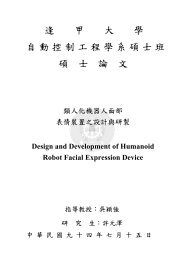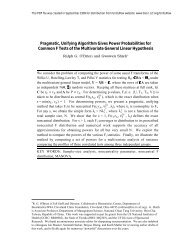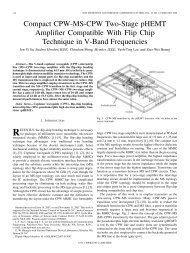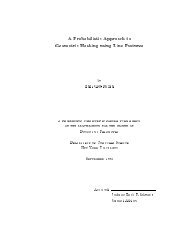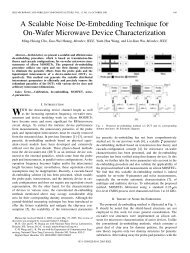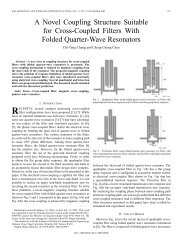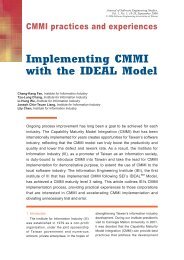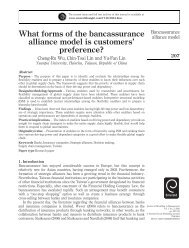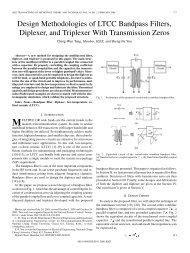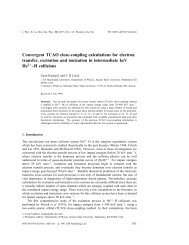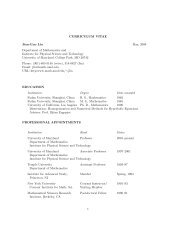Source Model for Transform Video Coder and its ... - ResearchGate
Source Model for Transform Video Coder and its ... - ResearchGate
Source Model for Transform Video Coder and its ... - ResearchGate
You also want an ePaper? Increase the reach of your titles
YUMPU automatically turns print PDFs into web optimized ePapers that Google loves.
290 IEEE TRANSACTIONS ON CIRCUITS AND SYSTEMS FOR VIDEO TECHNOLOGY, VOL. 7, NO. 2, APRIL 1997<br />
Fig. 4.<br />
Practical image trans<strong>for</strong>m coder.<br />
approximated by the following <strong>for</strong>mulas [4], [12]:<br />
<strong>and</strong><br />
Thus<br />
(9)<br />
(10)<br />
(11)<br />
where is 12 <strong>and</strong> is 1.386 ( ) <strong>for</strong> uni<strong>for</strong>m,<br />
Gaussian, <strong>and</strong> Laplacian distributions, is source dependent<br />
<strong>and</strong> is about one <strong>for</strong> uni<strong>for</strong>m distribution, 1.4 <strong>for</strong> Gaussian,<br />
<strong>and</strong> 1.2 <strong>for</strong> Laplacian, <strong>and</strong> is the signal variance. As<br />
shown by Figs. 2 <strong>and</strong> 3, the above approximations are fairly<br />
accurate when the quantization step size is smaller than the<br />
signal st<strong>and</strong>ard deviation. Combining (9) <strong>and</strong> (10) we obtain<br />
(12)<br />
This gives us a more direct relation between <strong>and</strong> .<br />
In image coding, b<strong>its</strong> are typically spent on a small percentage<br />
of dominant trans<strong>for</strong>m coefficients of which the allocated<br />
bit rates are often higher than a couple of b<strong>its</strong> per coefficient.<br />
Although there is no simple <strong>and</strong> accurate <strong>for</strong>mula <strong>for</strong> the low<br />
variance coefficients, these coefficients do not affect the overall<br />
model very much since their contribution in b<strong>its</strong> is relatively<br />
small. There<strong>for</strong>e, the above <strong>for</strong>mulas, although are accurate<br />
<strong>for</strong> medium to high bit rates, they are still practically useful<br />
<strong>for</strong> all the bit rates of interest.<br />
In a real system, the ideal entropy coder is typically replaced<br />
by a variable-length coder (VLC), a simplified version of<br />
Huffman code [13]. Assuming this VLC is nearly as efficient<br />
as the ideal entropy coder, the b<strong>its</strong> produced by this VLC, ,<br />
may be approximated by , where is the ideal entropy<br />
b<strong>its</strong> of the quantizer outputs, <strong>and</strong> is a scaling factor (<strong>for</strong><br />
adjustment) greater than one. Under this assumption, (12) may<br />
still be used <strong>for</strong> a practical scalar quantizer with a modified<br />
value of (to be discussed in Section V).<br />
III. PRACTICAL TRANSFORM CODER<br />
A practical image trans<strong>for</strong>m coder, such as the DCT coders<br />
used in [1]–[3], can be represented by the general block<br />
diagram in Fig. 4. It follows roughly the a<strong>for</strong>ementioned<br />
principles, namely, a trans<strong>for</strong>m (DCT) used to decompose<br />
the original pictures into nearly independent components, a<br />
uni<strong>for</strong>m scalar quantizer used to reduce the output levels, <strong>and</strong><br />
a VLC used to further compress the output bit stream. As<br />
compared to that described in Sections II-A <strong>and</strong> II-B, the individual<br />
entropy coders are replaced by a data model followed<br />
by an entropy coder. The objective of trans<strong>for</strong>mation <strong>and</strong> data<br />
model together is to produce (nearly) statistically independent<br />
data sequences so that they can be coded separately with high<br />
efficiency.<br />
The data model used in [1]–[3] simply rearranges the<br />
trans<strong>for</strong>m coefficients in a zigzag scan order. That is, the<br />
2-D array of a block of DCT coefficients are assembled<br />
to <strong>for</strong>m a zigzag scanned 1-D linear array or vector<br />
, in which the lower frequency’s DCT coefficients<br />
are usually associated with smaller indices. When<br />
the coefficients are ordered in this fashion, the variances of<br />
coefficients are approximately monotonically decreasing [2].<br />
If the trans<strong>for</strong>med source vector<br />
is<br />
stationary <strong>and</strong> every frequency component is independent, then<br />
the average entropy per block,<br />
, equals the<br />
sum of the entropies of all the components.<br />
According to [12] <strong>and</strong> [14], the conditions discussed in<br />
the above, to a great extent, satisfied; that is, the frequency<br />
components (trans<strong>for</strong>m coefficients) are nearly i.i.d. sources,<br />
the distortion of quantized coefficients are relatively small,<br />
<strong>and</strong> the VLC per<strong>for</strong>mance is close to that of the ideal entropy<br />
coder. Then, the behavior of such a trans<strong>for</strong>m coder can be<br />
derived from (9) or (11) by combining all the components<br />
together. Assuming the probability distribution of the frequency<br />
components is either uni<strong>for</strong>m, Gaussian, or Laplacian,<br />
<strong>and</strong> is the average b<strong>its</strong> of the th entropy-coded, quantized<br />
coefficient, the total average b<strong>its</strong> of such a source is<br />
(13)<br />
(14)<br />
where , , <strong>and</strong> are the distortion, the variance, <strong>and</strong><br />
the parameter associated with the th component. Since<br />
(10)<br />
(15)



